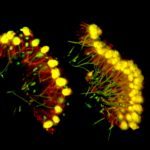Link to Pubmed [PMID] – 39233537
Link to DOI – 10.1111/boc.202400054
Biol Cell 2024 Nov; 116(11): e2400054
Microvilli are finger-like, straight, and stable cellular protrusions that are filled with F-actin and present a stereotypical length. They are present in a broad range of cell types across the animal tree of life and mediate several fundamental functions, including nutrient absorption, photosensation, and mechanosensation. Therefore, understanding the origin and evolution of microvilli is key to reconstructing the evolution of animal cellular form and function. Here, we review the current state of knowledge on microvilli evolution and perform a bioinformatic survey of the conservation of genes encoding microvillar proteins in animals and their unicellular relatives.We first present a detailed description of mammalian microvilli based on two well-studied examples, the brush border microvilli of enterocytes and the stereocilia of hair cells. We also survey the broader diversity of microvilli and discuss similarities and differences between microvilli and filopodia. Based on our bioinformatic survey coupled with carefully reconstructed molecular phylogenies, we reconstitute the order of evolutionary appearance of microvillar proteins. We document the stepwise evolutionary assembly of the “molecular microvillar toolkit” with notable bursts of innovation at two key nodes: the last common filozoan ancestor (correlated with the evolution of microvilli distinct from filopodia) and the last common choanozoan ancestor (correlated with the emergence of inter-microvillar adhesions).We conclude with a scenario for the evolution of microvilli from filopodia-like ancestral structures in unicellular precursors of animals.

